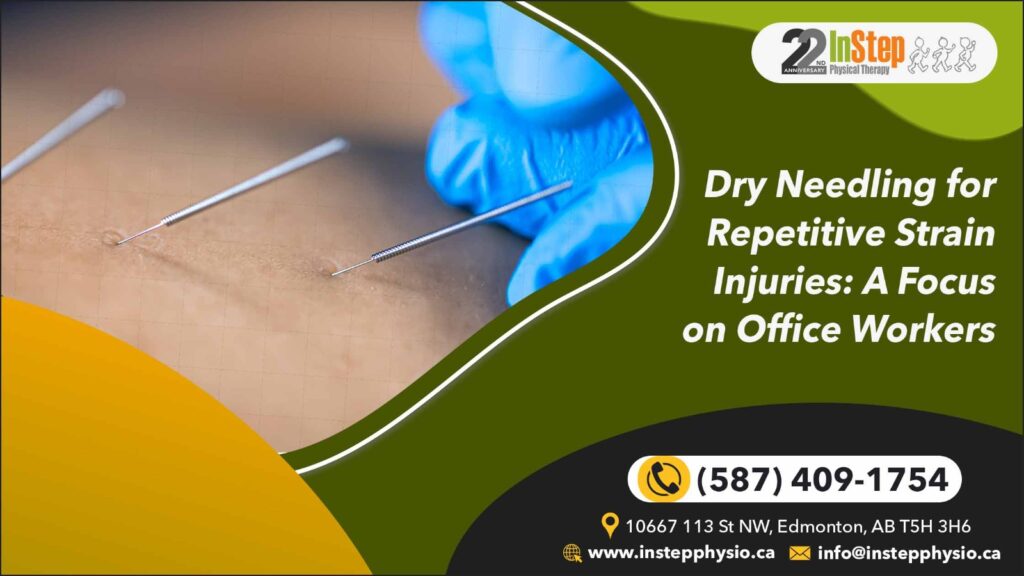Dry needling is a method used by physiotherapists and other healthcare professionals to manage musculoskeletal pain and movement impairments. It entails inserting thin, solid needles into specific trigger points or tight bands of muscle, aiming to relieve pain, enhance range of motion, and promote healing. Dry needling in Edmonton aims to rebalance energy flow in the body and targets myofascial trigger points, which are hyperirritable spots within the muscles associated with palpable nodules or taut bands.
Mechanism of Dry Needling:
Dry needling targets myofascial trigger points—painful knots found in muscles, which can contribute to pain and functional limitations. These trigger points are often the result of muscle overuse, which is common in office settings. The insertion of a slender, sterile needle into these points helps to:
Release Muscle Tension:
Upon insertion of the needle, it can cause the tight muscle to twitch and then relax, thus aiding in the alleviation of muscle tension and discomfort.
Reduce Pain:
Dry needling may trigger the release of endorphins and other neurochemicals that block pain signals to the brain, providing pain relief.
Promote Healing:
By maximizing blood flow to the targeted area, dry needling aids in the elimination of waste products and the transportation of nutrients to the tissues, facilitating the healing process.
How Dry Needling is Used for Repetitive Strain Injuries, Focus on Office Workers?
Dry needling is a therapeutic approach that has become increasingly popular for managing repetitive strain injuries (RSIs) in office workers. These injuries are common due to the repetitive nature of tasks such as typing, mouse use, and poor posture during long hours of desk work.
Repetitive Strain Injuries in Office Workers that Dry Needling can help with:
Carpal Tunnel Syndrome:
It is a common condition resulting from the constriction of the median nerve as it passes through the carpal tunnel in the wrist. This compression can result from repetitive hand and wrist movements, leading to inflammation and swelling within the narrow confines of the carpal tunnel. Dry needling can focus on muscles in the forearm and hand to alleviate tension and reduce compression on the median nerve.
Tennis Elbow (Lateral Epicondylitis):
Pain and inflammation on the outside of the elbow caused by repetitive gripping and wrist extension. The overuse strains the tendons attached to the lateral epicondyle of the humerus bone, leading to microtears and inflammation. Dry needling can aid in alleviating strain in the affected forearm muscles and reduce inflammation around the lateral epicondyle.
Neck and Shoulder Pain:
Neck and shoulder pain can significantly impact daily life, often stemming from prolonged sitting and poor posture, which place excessive strain on the muscles of the neck, shoulders, and upper back. This chronic discomfort and stiffness can impair mobility and quality of life, affecting both work and leisure activities. Dry needling can target trigger points in the neck, shoulders, and upper back to relieve muscle tension and improve range of motion.
Thoracic Outlet Syndrome:
It is a condition marked by the compression occurring between the collarbone and the first rib affecting nerves or blood vessels. This compression can result in a variety of symptoms, which may include pain, numbness, and tingling sensations in the neck, shoulder, and arm, often accompanied by weakness or a feeling of heaviness in the affected limb. Dry needling in Edmonton aids in the relaxation of tense muscles and fascia in the neck, shoulder, and chest regions, thereby easing pressure on the impacted structures.
De Quervain’s Tenosynovitis:
It is a condition characterized by inflammation affecting the tendons positioned on the thumb side of the wrist, resulting in pain and swelling in the wrist and thumb area. This inflammation can be triggered by repetitive thumb and wrist movements, such as grasping, lifting, or twisting motions. Dry needling can be directed at muscles in the forearm and hand to alleviate tension and inflammation surrounding the affected tendons.
Rotator Cuff Tendonitis:
Rotator cuff tendonitis is a painful condition resulting from inflammation of the tendons and muscles that encompass the shoulder joint, often induced by repetitive overhead arm movements like throwing, lifting, or reaching. This inflammation can lead to discomfort, limited movement and weakened strength in the affected shoulder. Dry needling aids in relieving tension within the rotator cuff muscles and enhancing shoulder mobility.
Trigger Finger/Thumb:
Trigger finger/thumb is a condition characterized by the digit becoming locked in a bent position due to inflammation of the tendon sheath. This inflammation impedes the smooth movement of the tendon through its sheath, leading to difficulty extending or flexing the affected finger or thumb. Dry needling is capable of addressing muscle tension and inflammation surrounding the affected tendon sheath by targeting muscles in the forearm and hand.
Lower Back Pain:
Lower back pain, a prevalent complaint, often arises from prolonged periods of sitting and adopting poor posture habits. Dry needling can focus on trigger points within the muscles of the lower back to relieve muscle tension and enhance mobility in the lumbar spine.
Tension Headaches:
Headaches caused by muscle tension and stress often get exacerbated by poor posture and prolonged screen time. These headaches, often characterized by dull, aching pain or tightness in the head and neck region, can interfere with work. Dry needling assists in alleviating tension present in the muscle groups spanning the neck, shoulder, and upper back, leading to a reduction in both the frequency and severity of headaches.
Enhancing Pain Relief and Mobility:
Dry needling in Edmonton offers a targeted approach to managing musculoskeletal pain and movement impairments. By precisely inserting thin needles into trigger points, In Step Physical Therapy in Edmonton aims to relieve pain, enhance range of motion, and promote healing. While dry needling therapy can be an effective component of a comprehensive treatment plan, it’s essential to seek care from qualified therapists trained in the technique. With proper guidance and supervision, dry-needling physiotherapy can offer significant relief for individuals suffering from a variety of musculoskeletal conditions.
Keywords: dry needling, dry needling Edmonton, dry needling therapy, dry needling physiotherapy, In Step Physical Therapy Edmonton
